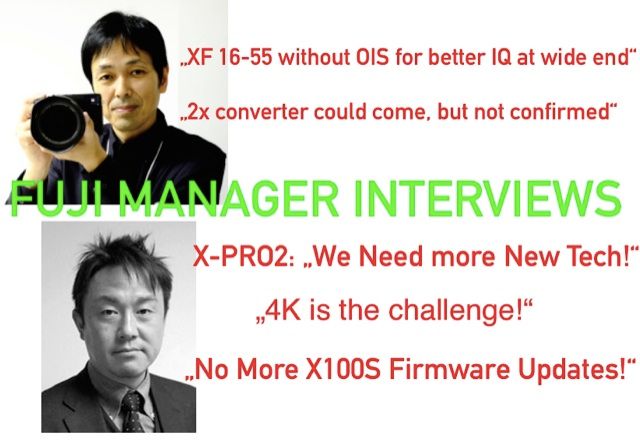INTERVIEWS: X-PRO2: “We need more New Technologies!” X100S: “No More FW Updates!” 2x converter “Could come!”

Time for another series of interviews with Fujifilm Managers… let’s start with the main points in the one imaging-resource had with Makoto Oishi from the Sales & Marketing Division, Optical Device & Electronic Imaging Products Division.
4K:”Currently, our X-Trans CMOS II [sensor] cannot realize 4K videos because it has a smaller number of pixels, like 16-megapixel. Also, if we [want to] realize 4K video, the sensor itself should have much faster reading speed.”
I remind you that our trusted Japanese source confirmed a few weeks ago, that Fuji’s plans are to make the X-PRO2 4K capable.
X100S firmware: “While we have provided firmware upgrades for the X100S many times, now we have the X100T, we’re finished, no firmware upgrades [for the X100S] anymore.”
Frankly disappointing, if true. I can understand that they hold on with the FW release, since the X100T is relatively new, and a new X100S firmware would probably influence negatively the sales… but on the long term Fuji must update the X100S. X100S owners are a VERY important part for Fuji’s success, so they deserve an update. At least Classic Chrome… David Hobby himself said here to have used it on his X100S… so why not all the other X-shooters too?
X-PRO2: “But if we launched an X-Pro, we’d need more new technologies, and we’re still developing and investigating. Especially the new devices like the processor or sensor, we’re still preparing.”
There is more to read at imaging-resource, for example about the gyro sensor used for the OIS in the 50-140. A technology missing in the 16-55… and in another interview at fujifilm-blog another manager (Mr Soga, the man responsible for the lens roadmap) explains the true reason for the lack of OIS: it’s not about size, it’s not about costs… it’s about IQ at the wide end (16mm)! He says:
“OIS needs to move the lens inside to compensate for camera shake and as a result can cause loss of resolution in the edges of the image. In long zoom lens such as the XF50-140mmF2.8, the angle of view is narrow enough to not show this negative effect of OIS in the edges. However, the angle of view of the XF16-55mm, when set to the widest setting, is large enough for OIS to affect resolution at the edge of the image. Considering this trade-off, because we wanted this zoom lens to start wide at 16mm and F2.8, and we wanted to best edge-to-edge quality throughout the entire zoom range, we decided to not employ OIS.”
Mr. Soga also confirms that teh XF 35mmF2 will have faster focussing and “we may create a 2x converter in the future although this has not been confirmed.”
Read more at imaging-resource and fujifilm-blog.

